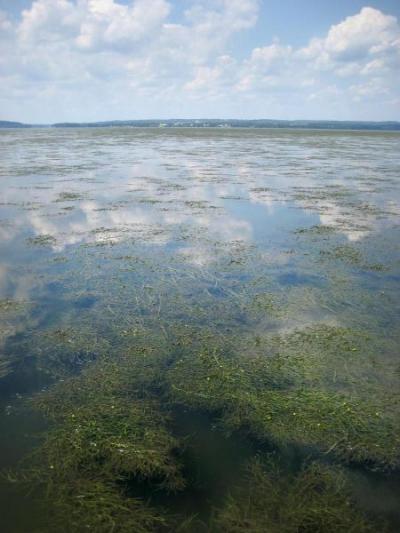CAMBRIDGE, MD (May 26, 2016)—An expansive bed of underwater grass at the mouth of the Susquehanna River has proven it is able to “take a licking and keep on ticking.” A recent study has found that the submersed aquatic vegetation (SAV) bed at Susquehanna Flats, which only recently made a comeback in the Chesapeake Bay, was not only able to survive a barrage of rough storms and flooding, but it has proven a natural ability to protect and maintain itself.
 “It’s proof that restored SAV beds have the capability to be resilient,” said study author Cassie Gurbisz of the University of Maryland Center for Environmental Science’s Horn Point Laboratory. “They can stick around for a while if you give them the right conditions.”
“It’s proof that restored SAV beds have the capability to be resilient,” said study author Cassie Gurbisz of the University of Maryland Center for Environmental Science’s Horn Point Laboratory. “They can stick around for a while if you give them the right conditions.”
Some 40 years ago, Tropical Storm Agnes wiped out the Susquehanna Flats SAV bed, which had already been weakened by decades of nutrient pollution. In recent years, however, the bed made an incredible comeback, and today it is one of the biggest and healthiest in the Bay, spanning some 20 square miles.
It has been projected that climate change will bring increases in the frequency and intensity of extreme storm events, which leads to the question of whether or not these ecosystems can withstand or rebound from such events. Scientists studied how the bed at Susquehanna Flats responded to the one-two punch of major storms in 2011 (Hurricane Irene and the remnants of Tropical Storm Lee) to find how resilient the underwater grasses are in the upper Chesapeake.
Sea grasses are essential to the Bay ecosystem. They pull harmful nutrients out of the water, cause sediments to settle to the bottom so sunlight can reach plants, protect the shoreline by reducing the impact of waves and currents, and provide habitat and food for a host of important organisms, including baby crabs.
 The team of scientists looked at time series datasets to explore how extreme events impacted the Susquehanna Flats and to understand the factors that drove loss and resilience in this large, dense and continuous meadow of grasses. They found that the storms in 2011 did some damage to the bed at Susquehanna Flats because the rush of the water from the Susquehanna River tore up plants around the edge of the bed and deposited sediment that blocked the sunlight, limiting photosynthesis.
The team of scientists looked at time series datasets to explore how extreme events impacted the Susquehanna Flats and to understand the factors that drove loss and resilience in this large, dense and continuous meadow of grasses. They found that the storms in 2011 did some damage to the bed at Susquehanna Flats because the rush of the water from the Susquehanna River tore up plants around the edge of the bed and deposited sediment that blocked the sunlight, limiting photosynthesis.
However, the bed was able to reduce the force of high flows sufficiently to prevent plant erosion at its inner core. In addition, although the floodwaters dumped a lot of sediment onto the SAV bed, it also dampened the waves driven by the winds. This decreased the amount of sediment that was later churned up and, as a result, increased water clarity. In fact, clear water spilled over into adjacent regions during ebb tide, further improving the bed’s capacity for renewal by creating more favorable growing conditions in areas where plant loss had occurred.
“Although there was substantial SAV loss in response to a major flood event, the system was also remarkably resilient, apparently owing to strong biophysical feedback processes carried out by a large, dense, healthy SAV bed,” said Gurbisz.
It’s called a positive feedback process. The plant beds alter physical conditions in ways that enhance their own growth – and it may help plant beds absorb the harmful impacts of storms. For instance, the plants create clear water in the middle of the bed, which promotes more plant growth, further improving water clarity, and so on. When that clear water spills out of the plant bed into the surrounding water, more light is available for new plants to grow. Together, these processes create conditions that allow the bed to resist damage and recover more quickly from the rush of water and sediments from storms.
“The SAV bed modifies its environment in ways that improve its own growth and likely serve as mechanisms of SAV resilience to flood events,” said Gurbisz.
The study, “Mechanisms of storm-related loss and resilience in a large submersed plant bed” by Gurbisz, Michael Kemp, and Larry Sanford of the University of Maryland Center for Environmental Science and Robert Orth of the Virginia Institute of Marine Science was published in Estuaries and Coasts.
“This study, which is part of Cassie’s graduate student research, is an example of the wonderful scientific investigations our graduate students conduct to improve understanding of Chesapeake Bay,” said Mike Roman, director of the Horn Point Laboratory.
UNIVERSITY OF MARYLAND CENTER FOR ENVIRONMENTAL SCIENCE
For 90 years, the University of Maryland Center for Environmental Science has led the way toward better management of Maryland’s natural resources and the protection and restoration of the Chesapeake Bay. From a network laboratories located across the state, UMCES scientists provide sound advice to help state and national leaders manage the environment, and prepare future scientists to meet the global challenges of the 21st century.
# # #

